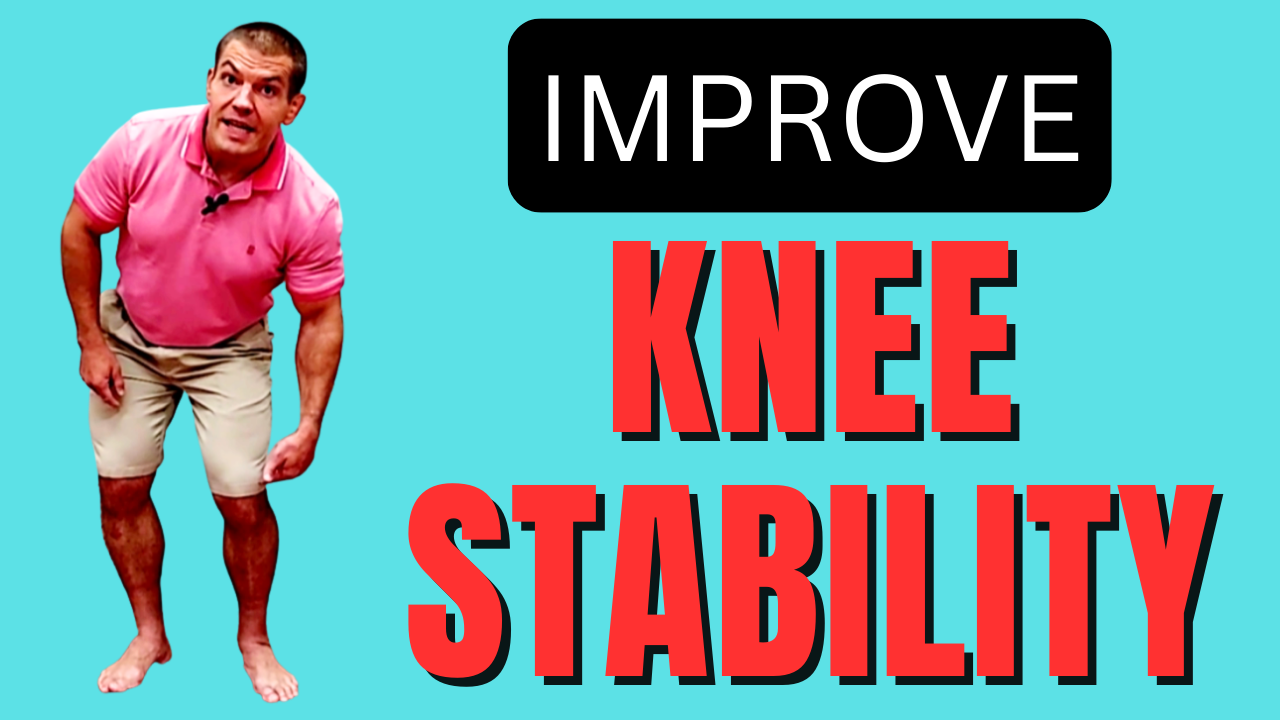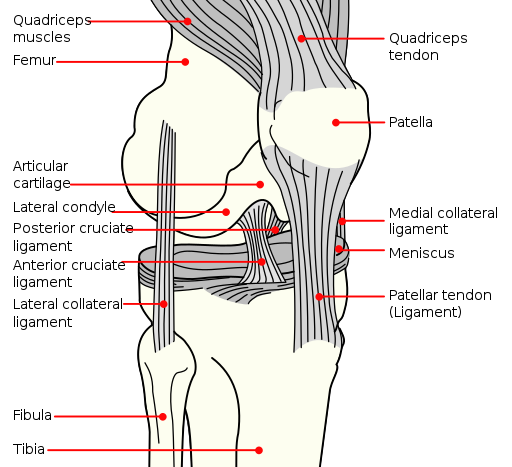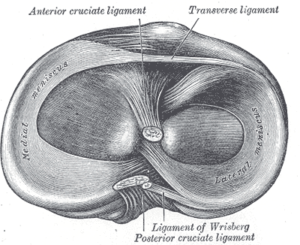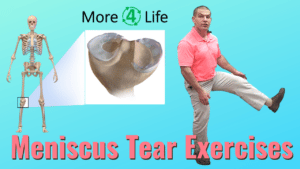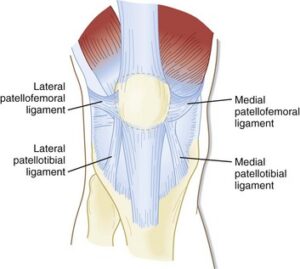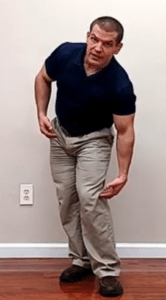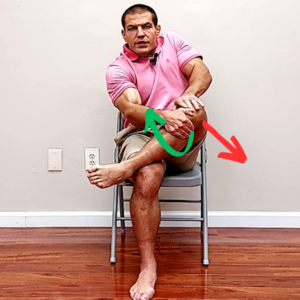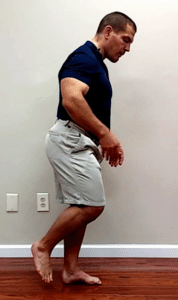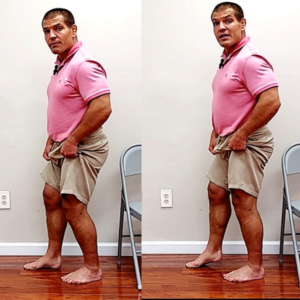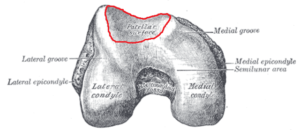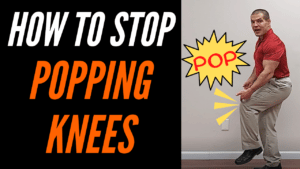Does Your Knee Feel Weak And Unstable Like It May Give Out?
Watch this video to learn what may cause your knee to feel unstable. Plus learn 4 knee stability exercises to improve your knee stability and prevent falls. Some of the them may even work immediately.
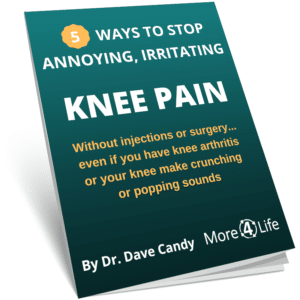
What Make You Knee Feel Weak And Unstable?
Before we get started, it helps to understand what gives your knee structural stability in the first place.
Ligaments of the knee
There are a lot of really strong ligaments that surround your knee joint and give it stability.
Those ligaments are the:
- Medial Collateral Ligaments (MCL) on the inner side of your knee
- Lateral Collateral Ligament (LCL) on the outer side of your knee.
- Anterior Cruciate Ligament (ACL) inside the knee joint
- Posterior Cruciate Ligament (PCL) inside the knee joint
- Medial Patellar Retinaculum on the inner side of the kneecap
- Lateral Patellar Retinaculum on the outer side of the kneecap
The Collateral Ligaments Of The Knee Provide Side To Side Stability
The medial collateral ligament provide medial stability of the knee by preventing it from buckling inwards.
The lateral collateral ligament provides lateral knee stability by preventing your knee from going outwards too far.
The Cruciate Ligaments Of The Knee
Inside the knee joint, you have two ligaments called the cruciate ligaments because of their cross-like orientation. Specifically, you have the ACL or anterior cruciate ligament, and then the posterior cruciate ligament or PCL.
The cruciate ligaments provider front-to-back stability of your knee.
They prevent your knee from hyperextending, and they also prevent your femur (thigh bone) from rolling off the back of your tibia as you go to bend your knee or squat.
However, there's another really important function of the two cruciate ligaments. They also control the rotational stability of your knee.
The ACL prevents your knee from twisting too far inwards (tibial internal rotation).
The PCL prevents your knee from twisting too far outwards (tibial external rotation).
Medial and Lateral Meniscus
Additionally, you have menisci or fibrocartilage that surrounds the inner and outer sides of the knee.
The medial meniscus is on the inner side of the knee, and the lateral meniscus is on the outer side of the knee.
The menisci deepen the joint surface of the knee joint and help improve knee stability.
Small meniscus tears usually don't give you very much instability, but if you have a larger meniscus tear, that can give you a little bit of instability in your knee.
Patellar Retinaculum
Finally, you have little ligaments on either side of your kneecap, the medial patellar retinaculum and the lateral patellar retinaculum.
These ligaments provide side-to-side stability of your kneecap.
How Do You Know If Your Knees Are Unstable?
If you've torn one of the ligaments in your knees or sprained badly, your knee can become structurally unstable.
So how can you tell if you actually have structural instability of your knees?
Well, the good news is that your knee ligaments are very, very strong.
Therefore, it's likely that your knees aren't actually unstable. They may just feel unstable.
You'd have to have a pretty traumatic injury like a sports injury or a fall in order to injure one of those ligaments.
In hat case, it's not just going to hurt when you put weight on it.
It may feel unsteady like it's not going to hold your weight. Or, it may actually buckle causing you to fall.
Now if you are in the situation where you feel like you really just can't bear weight on your knee, it is important that you seek help for it right away.
A skilled orthopedic physical therapist can do clinical tests to check the structural integrity of the ligaments in your knee joints.
Again, structurally unstable knees are rare unless there's been a traumatic injury.
What To Do If Your Knees Are Structurally Unstable
If your knee ligaments have been overstretched or torn, you're probably going to need hinged knee brace.
It should have bars on the sides that give you extra stability to the knee. Here's one example.
NEENCA Professional Knee Brace for Knee ...
$59.89 (as of July 26, 2024 09:30 GMT -05:00 - More infoProduct prices and availability are accurate as of the date/time indicated and are subject to change. Any price and availability information displayed on [relevant Amazon Site(s), as applicable] at the time of purchase will apply to the purchase of this product.)In the case of a very severe ligament injury, there's also a possibility that you may require surgery.
So if your knee is giving out on you when you're putting weight on it, it is important to get help for it right away.
Why Your Knee Feels Weak and Unstable Even If It Isn't Structurally Unstable
For most people who have a knee that feels weak and unstable, it's not actually structural instability.
What would cause that?
Well, your ligaments aren't just like strings that tie your joints together.
They have receptors in there that tell your brain where your knee is in space.
If your knee slips slightly out of alignment one way or the other, it puts tension on those ligament receptors. That in turn sends a message to your brain, telling it there's a potential risk for injury.
So that feeling of instability, like your knee may give away, is actually a protective signal telling you to do something before you actually injure your ligaments.
How To Improve Knee Stability
One of the most common ways that people get a feeling of instability is rotational instability.
Oftentimes, that comes from overpronating (flattening) your foot where your knee goes inwards when you're walking.
As you can see, that motion pattern puts a lot of stress on your medial collateral ligament.
It also kind of twists on the menisci inside the joint and puts some strain on your cruciate ligaments.
What happens when you overpronate or your knee goes inwards too far is you get internal rotation of your femur and external rotation of your tibia.
I you've been walking like this for awhile, then you may start to lack internal rotation of your lower leg.
That in turn can make your knee feel a bit unstable.
Additionally, the tibia may slide one way or the other, which can also make your knee feel unstable.
So here are some tips you can use to help improve knee stability by aligning the joint properly so that you start to feel better right away.
Knee Stability Exercise 1
The first knee stability exercise is really more of a self-mobilization.
To do the exercise, sit in a char and cross the ankle of one leg over the knee of the other.
Take the opposite hand and wrap it around the lower leg bone (tibia), close to the joint line.
With the other hand push on the inner side of your thigh, again close to the knee joint.
So what you're doing is you're sort of rotating the tibia inwards while also translating it a little bit inwards.
Hold this stretch for about 1 minute.
This helps realign the joint knee joint surface to make your knee more stable.
Essentially, it's undoing the positional fault in the knee that results from walking with excessive pronation.
Knee Stability Exercise 2
After you've restored the passive internal rotation of your tibai, next you want to use your muscles to do that actively.
There's aren't many muscles that directly internally rotate your knee, but there is one tiny one called the popliteus.
Additionally, your inner hamstrings attach right on the inside of the knee.
Therefore, you can use the hamstrings, particularly the semitendinosus (green) and the semimembranosus (blue), to help internally rotate your knee as well.
How to do the exercise
Sit with your knee bent about 90 degrees.
Turn your foot inwards which will cue your popliteus to turn on.
Then bend your knee which will activate the hamstring muscles.
Do that for 10 or 15 repetitions, kind of going back and forth with the knee while holding the foot inwards to maintain a position of tibial internal rotation.
Knee Stability Exercise 3
After you've done those two exercises, you need to control the pronation motion that caused your the problem in the first place.
Weak hip external rotators, weak foot and ankle muscles, and tight calves are largely at fault for overpronating your foot.
Therefore, one of the best ways to help improve knee stability is to practice standing on one leg with your arch lifted and your knee turned out.
When you turn your knee out, that causes hip external rotation, but the tibia rotates inward relative to the femur.
You may need to hold onto something for balance initially. Then as your balance and stability improve, you can try doing the exercise without holding on.
So that's the third exercise.
Knee Stability Exercise 4
Now, what about front-to-back stability of your knee?
If you feel like your knee is going to buckle or bend when you put weight on it you may not be getting your knee fully locked out.
When you go into full knee extension, your two cruciate ligaments, your ACL and PCL, cross and lock the knee in extension.
This allows you keep your knee stabile without having to use your muscles.
However, if you can't get into full knee extension, then you have to use your quadriceps muscles throughout your walking cycle to maintain the stability of your knee.
If you lack full knee extension, here's an exercise that can help improve your knee stability.
That exercise is called a terminal knee extension.
To do the terminal knee extension, place one foot on the ground and the other in front.
The back leg will be the one that you're exercising.
Tighten the thigh muscles of the back leg so that your knee goes from a slightly unlocked position to a locked position.
This exercise helps improve your knee extension and front-to-back knee stability.
Tips For Kneecap Instability (Patellofemoral Instability)
One other thing that we haven't talked about yet is the kneecap stability.
So far, we've talked about the tibiofemoral joint where the knee actually bends. However, there's also joint between your kneecap and your thigh.
If you've either injured the patellofemoral ligaments (retinacula) on the sides of the kneecap, the kneecap can slip out of the patellofemoral grove of the thigh bone.
This doesn't actually cause the knee to be structurally unstable, but it's painful and can cause the feeling of instability.
The most common way that the kneecap slips out of the groove is to the outside of the knee. This often happens due to overpronation. Additionally, some people are naturally born with a shallower patellovemoral groove.
Patellofemoral Stability Braces
If your kneecap is popping out of place, a patellofemoral stability brace can help.
BraceAbility J Patella Knee Brace - Late...
$59.99 (as of July 26, 2024 09:30 GMT -05:00 - More infoProduct prices and availability are accurate as of the date/time indicated and are subject to change. Any price and availability information displayed on [relevant Amazon Site(s), as applicable] at the time of purchase will apply to the purchase of this product.)The brace should have a hole for your kneecap. It should also have pad on the outside to help keep that kneecap from sliding laterally.
(Note: The model in this picture has the C-shaped support on the wrong side of the knee.)
Although a patellofemoral stability brace can help, it's still important to treat the muscle imbalances that caused your knee instability in the first place. Tha may include strengthening your hips, stretching your calves, and improving your balance.
Additionally, here are some more tips for a knee that pops.
Conclusion
Hopefully this post helped you better understand why your knee feels unstable and what knee stability exercises you can do to help.
If you live in the St. Louis area and need more help to improve your knee stability, tap the button below to request an appointment with one of our specialist physical therapists.

